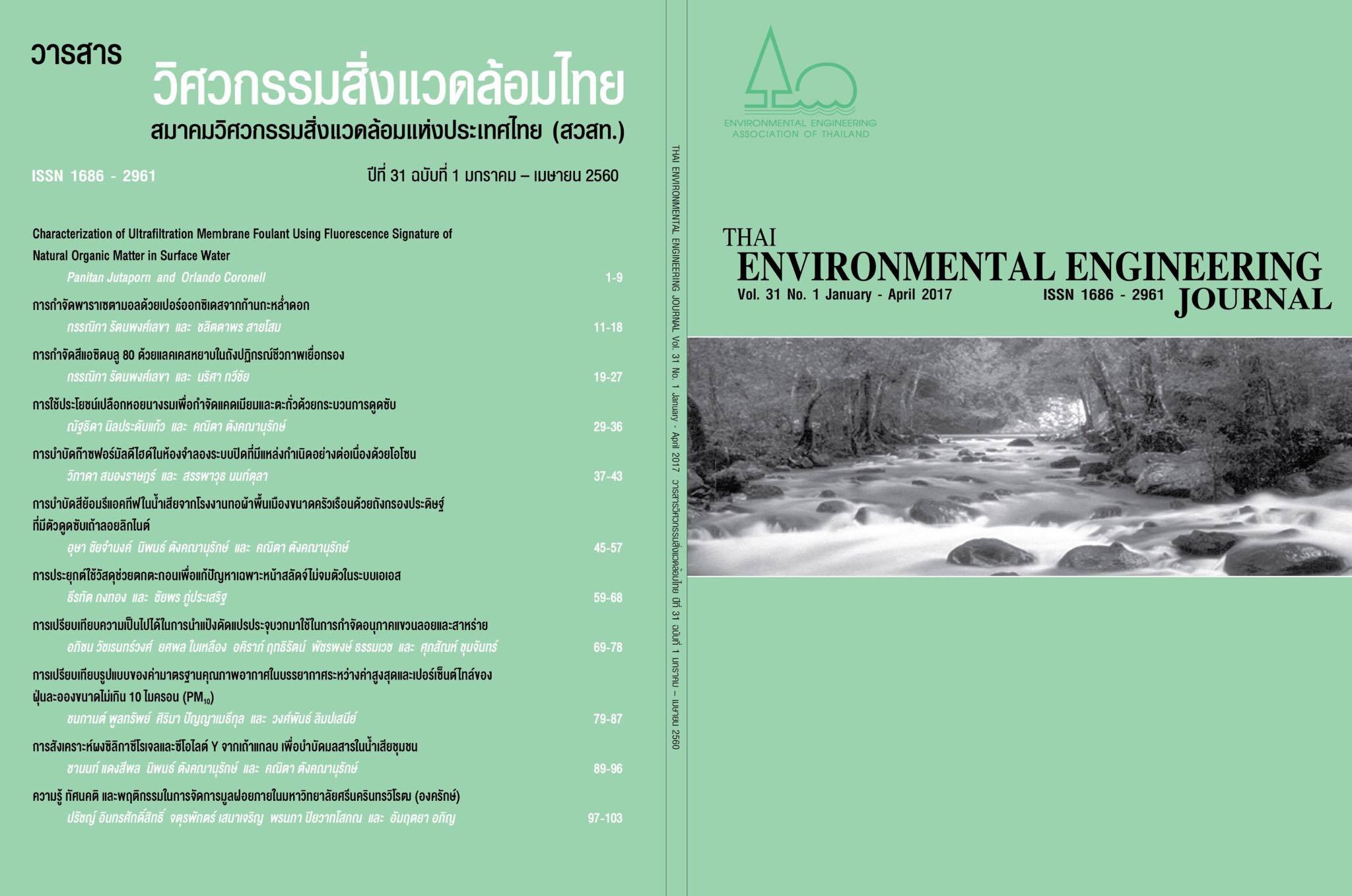Characterization of Ultrafiltration Membrane Foulant Using Fluorescence Signature of Natural Organic Matter in Surface Water
Main Article Content
Abstract
This study evaluates the role of natural organic matter (NOM) fractions from surface water in Polyvinylidene fluoride (PVDF) ultrafiltration (UF) membrane fouling using fluorescence excitation-emission matrices (EEMs). The hollow fiber filtration experiments were performed using four surface water sources as raw and pretreated with magnetic ion exchange (MIEX) resin. Fouling potentials were quantified and the NOM in raw, and treated feed water, permeate, and backwash waters were characterized in terms of NOM concentration and composition. Results showed that: (i) microbial protein-like NOM is a more important contributor to fouling than terrestrial humic-like NOM; (ii) UF membrane fouling potentials of surface water sources before and after MIEX pretreatment were strongly correlated to the fluorescence of microbial NOM at excitation-emission coordinates of 275 nm/340 nm. Overall, the high predictive power of fluorescence EEM to fouling potential suggests its potential use as a tool for the evaluation of fouling potential of surface water.
Article Details
References
[2] K. J. Howe and M. M. Clark. 2002. Fouling of microfiltration and ultrafiltration membranes by natural waters. Environ. Sci. Technol. 36(16): 3571-3576.
[3] P. C. Singer and K. Bilyk. 2002. Enhanced coagulation using a magnetic ion exchange resin. Water Res. 36: 4009-22.
[4] P. G. Coble. 1996. Characterization of marine and terrestrial DOM in seawater using excitation-emission matrix spectroscopy. Mar. Chem. 51(4): 325–346.
[5] J. Chen, E. J. LeBoeuf, S. Dai, and B. Gu. 2003. Fluorescence spectroscopic studies of natural organic matter fractions. Chemosphere. 50: 639-647.
[6] D. M. McKnight, E. W. Boyer, P. K. Westerhoff, P. T. Doran, T. Kulbe, and D. T. Andersen. 2001. Spectrofluorometric characterization of dissolved organic matter for indication of precursor organic material and aromaticity. Limnol. Oceanogr. 46(1): 38-48.
[7] S. A. Baghoth, S. K. Sharma, and G. L. Amy. 2011. Tracking natural organic matter (NOM) in a drinking water treatment plant using fluorescence excitation-emission matrices and PARAFAC. Water Res. 45(2): 797-809.
[8] K. R. Murphy, A. Hambly, S. Singh, R. K. Henderson, A. Baker, R. Stuetz, and S. J. Khan. 2011. Organic matter fluorescence in municipal water recycling schemes: toward a unified PARAFAC model. Environ. Sci. Technol. 45: 2909-2916.
[9] P. Jutaporn, P. C. Singer, R. M. Cory, and O. Coronell. 2016. Minimization of short-term low-pressure membrane fouling using a magnetic ion exchange (MIEX®) resin. Water Res. 98: 225-234.
[10] L. Fan, T. Nguyen, F. A. Roddick, and J. L. Harris. 2008. Low-pressure membrane filtration of secondary effluent in water reuse: Pre-treatment for fouling reduction. J. Membrane Sci. 320: 135-142.
[11] H. Huang, T. A. Young, and J. G. Jacangelo. 2008. Unified Membrane Fouling Index for Low Pressure Membrane Filtration of Natural Waters: Principles and Methodology. Environ. Sci. Technol. 42: 714-720.
[12] T. Ohno. 2002. Fluorescence inner-filtering correction for determining the humification index of dissolved organic matter. Environ. Sci. Technol. 36(4): 742-746.
[13] D. N. Kothawala, K. R. Murphy, C. A. Stedmon, G. A. Weyhenmeyer, and L. J. Tranvik. 2013. Inner filter correction of dissolved organic matter fluorescence. Limnol. Oceanogr. Methods. 11: 616-630.
[14] J. yu Tian, M. Ernst, F. Cui, and M. Jekel. 2013. Correlations of relevant membrane foulants with UF membrane fouling in different waters, Water Res. 47: 1218-1228.
[15] T. H. Boyer and P. C. Singer. 2006. A pilot-scale evaluation of magnetic ion exchange treatment for removal of natural organic material and inorganic anions, Water Res. 40(15): 2865-2876.


